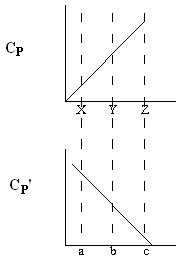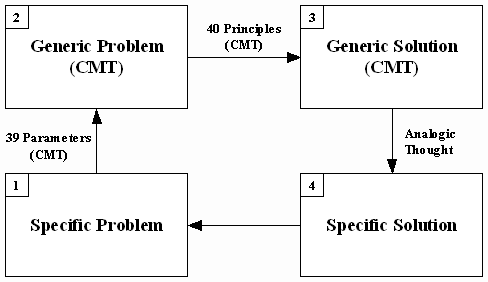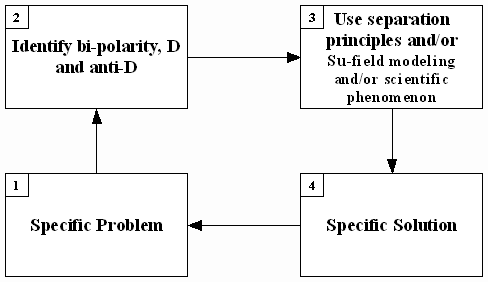
Solution Dynamics as a Function of Resolution Method
(Physical Contradiction v. Technical Contradiction)
Michael S. Slocum, K.O.St.I., Ph.D.
Ontro, Inc.
13250 Gregg Street
Poway, CA 92064 USA
mslocum@ontro.com
Ellen Domb, Ph.D.
PQR Group
190 North Mountain Avenue
Upland, CA 91786 USA
Ellendomb@compuserve.com
(Corresponding author)
Catherine Lundberg, B.Sc.
Ontro, Inc.
clundberg@ontro.com
{Editorial Note: The authors recognize that the sample size this analysis is based on is small and they encourage other researchers to contribute to this research.}
Abstract
Some teachers of TRIZ, and particularly those who base their teaching method on the use of ARIZ, have made the claim that higher level solutions to problems are generated by analyzing the physical contradictions that give rise to the problem, relative to the solutions generated by addressing the technical contradictions.
Ontro Inc. has evaluated 319 solved problems related to the technology of self-heating food containers during the last three years. These cases were used as a database to evaluate the effectiveness of problem solving from the physical contradiction and technical contradiction points of view.
Four measures of the level of innovation were developed, with priority given to solutions that were implemented in products, solutions that resulted in patents or patent disclosures, and solutions that resulted in declarations of trade secrecy (and the decision not to pursue patents for competitive reasons). The highest implementation effectiveness rating was found for problems that had been analyzed both as physical and technical contradictions. This result has led to a decision to analyze all problems from both points of view in the future, regardless of the original formulation of the problem.
1. Introduction
Problems are resolvable utilizing a number of solution techniques available to the TRIZ practitioner. Basic solution techniques may be applied, or as necessary, advanced techniques may be used. Table 1 divides these techniques into basic and advanced groups (1,2,3,4,5).
Table 1: TRIZ Techniques for Problem Resolution (not inclusive) (1,2)
| Basic Methods | Advanced Methods |
| Contradiction Matrix Theory (CMT) | Su-Field Modeling |
| Ideal Final Result (IFR) | ARIZ |
| Use of Resources |
It is Contradiction Matrix Theory (CMT) that is of primary concern in this research paper.
2. Contradiction Matrix Theory
A specific technical problem, when described using the contradiction approach, may be classified as a technical contradiction (TC), a physical contradiction (PC), or an administrative contradiction (AC). These contradictions may be represented utilizing the common phrasing found in Table 2:
Table 2: Contradictory Phraseology (1,3)
| Technical Contradiction (TC) | An action is concurrently useful (FU) and harmful (Fh). |
| Physical Contradiction (PC) | The system should have property A and property A- (anti-A). |
| Administrative Contradiction (AC) | A solution is required without a known solution direction. |
The technical and physical contradictions will be addressed to further prepare the foundation of our discovery.
2.1 Technical Contradiction (TC)
Consider two performance characteristics of a technical system (TS) Cp and Cp�. Also, allow three levels of adjustment for Cp and Cp�; Cp{x,y,z} and Cp�{a,b,c}. As Cp improves in response to stimuli x, y, and z the resultant Cp� response is reflected in a negative slope for a, b, and c (1).

Figure 1: A graphic representation of a technical contradiction
Enhancing the performance for Cp has an inverse effect on Cp�. This dependence is the central tenant of the technical contradiction. This inverse-dependence must be broken in order to remove the TC and produce a solution that will increase the ideality of the system (1).
2.1.1 Contradiction Matrix Theory (CMT)
The resolution of the TC follows a simple algorithm where basic steps are represented in Figure 2:

Figure 2: CMT Algorithm where steps 2 and 3 are the primary functioning elements (1,6,7,8).
The CMT solution space is therefore defined by the matrix structure inherent in the contradiction matrix:

Figure 3: CMT Solution Space
The contradiction definition is highly subjective as the situation may be defined (within the limited available permutations) in many different manners. Each problem definition (step 2) yields several innovative principles (40 Principles utilized transitioning from step 2 to step 3) that must be connected to the specific problem and any potential resolution using analogic thought (which is very difficult to master for a large sub-set of potential CMT users).
2.2 Physical Contradiction (PC)
Consider a technical system (TS) where there is a requirement for a characteristic, D, and a requirement for the equivalent anti-characteristic, D-. A technical system with this bi-polar feature requirement is approachable in the TRIZ system by employing the following heuristic:
Table 3: Removing the Physical Contradiction (1,3)
| Separate the bi-polarity in: Space Time Scale Upon Condition |
| Utilization of Su-Field Modeling |
| Utilization of Scientific Effects |
The algorithm for resolution of a physical contradiction is represented in Figure 4:

Figure 4: Physical Contradiction Algorithm (1,6,7,8)
This algorithm is devoid of the strong reliance on the analogic thought phase prevalent in the resolution of a technical contradiction (see Figure 2 Steps 3 and 4). The lack of a solution matrix also allows solution vectoring to progress in a completely unrestricted manner.
It is important to note that technical contradictions may be converted to physical contradictions and vice versa. This allows for the possibility of each problem present in a TS to be assessed utilizing the processes summarized in Figures 2 and 4. If the solution space for a TC is defined by {T} and the solution space for a PC is defined by {P} and (from the previous discussion) {P}>{T}; then [{P}+{T}]>>{P} or {T}. Data to support this conjecture is presented in the following section.
3. Supporting the Conjecture; [{P}+{T}]>>{P} or {T}
A log of problems and solutions is kept at Ontro, Inc. This log was utilized to provide core data for analysis to support (or refute) the aforementioned conjecture. Table 4 indicates the problems reviewed as categorized by the year in which they were addressed.
Table 4
| Year | Number of Problems |
| 1999 | 66 |
| 2000 | 106 |
| 2001 | 112 |
| 2002 | 35 |
| Total | 319 |
The problem set was evaluated for the particular contradiction structure that was utilized for resolution. In all of the cases there where several methods of resolution employed but the foundational contradiction was either a TC or a PC(2). Table 5 presents this distribution:
Table 5: Solution Volume as a Function of Method
| Contradiction Type | Volume | Solution Volume Based on Method | |||
| CMT | Sep Pr. | ARIZ | Su-Field | ||
| Pure TC | 212 | 180 | N/A | 21 | 49 |
| Pure PC | 64 | N/A | 119 | 9 | 12 |
| TC and PC | 43 | 132 | 74 | 15 | 31 |
Table 6: Total Solutions Based on Contradiction Type
| Contradiction Type | Total Solutions |
| Pure TC | 250 |
| Pure PC | 140 |
| TC and PC | 252 |
Table 7: Solution Density (Total Solutions/Contradiction Volume)
| Contradiction Type | Solution Density, SOLd |
| Pure TC | 1.18 |
| Pure PC | 2.19 |
| TC and PC | 5.86 |
The potential solutions produced during the application of the TRIZ Methodology were either reduced to practice (implemented) or discarded due to perceivably insurmountable secondary problems. Those solutions that were implemented in part or entirety were considered to have been completely implemented. The implementation strength is presented in Table 8:
Table 8: Implementation
| Contradiction Type | Implementation, SOLi |
| Pure TC | 0.7625 |
| Pure PC | 0.5714 |
| TC and PC | 0.8006 |
Considering the solution density (SOLd) and the solution implementation (SOL i), several cursory conclusion may be made:
The strength of the implemented solutions was also considered as an important component of this evaluation. Altshuller�s Levels of Innovation were utilized as the metric by which an implemented solution was rated. Table 9 demonstrates the implemented solution innovative level as a function of TC, PC, or TC and PC:
Table 9: Innovative Levels of Implemented Solutions*(3)
| Innovative Level | Contradiction Type | ||
| TC | PC | TC and PC | |
| 5 | 0 | 0 | 0 |
| 4 | 2 (8) | 1 (4) | 4 (16) |
| 3 | 5 (15) | 2 (6) | 7 (21) |
| 2 | 6 (12) | 2 (4) | 5 (10) |
| 1 | 67 (67) | 16 (16) | 9 (9) |
| Total | 80 (102) | 21 (30) | 25 (56) |
A composite solution strength score was determined by multiplying the number of solutions for each innovative level by the level itself. This yielded raw scores as demonstrated in Table 10:
Table 10: Raw Solution Strength
| Contradiction Type | Raw Solution Strength |
| Pure TC | 102 |
| Pure PC | 30 |
| TC and PC | 56 |
The Raw Solution Strength was then divided by the total number of implemented solutions to yield the Solution Strength (SOLstr):
Table 11: Solution Strength (SOLstr)
| Contradiction Type | SOLstr |
| Pure TC | 1.275 |
| Pure PC | 1.429 |
| TC and PC | 2.240 |
Since we have gathered several quantitative scores for the problems under review we may now calculate composite scores for each contradiction type:
Table 12: Composite Scores as a Function of Contradiction Type
| Contradiction Type | SOLd | SOLstr | Implementation | Composite Score |
| TC | 1.18 | 1.275 | 0.7625 | 1.15 |
| PC | 2.19 | 1.429 | 0.5714 | 1.79 |
| TC and PC | 5.86 | 2.240 | 0.8006 | 10.51 |
4. Conclusions:
The solution density, solution strength, and implementation of solutions to problems that were analyzed both as physical and technical contradictions yielded higher scores in all three metrics and subsequently the composite score by an order of magnitude. Although the problems treated as physical contradictions had a higher composite score than those analyzed by technical contradictions, the extremely high composite score of those treated both way suggests that we should stop trying to decide how to treat a problem, and treat all problems both ways.
References:
About the Authors:
Michael S. Slocum, K.O.St.I., Ph.D.
Vice President of Science and Engineering, Ontro
With over 14 years of research and development experience at
ITT Space and Special Projects and the U.S. Army Military Intelligence, Dr.
Michael Slocum has become an expert in Problem Solving, Research and
Development, Engineering, and Quality. In Dr. Slocum's career, he has worked on
the TITAN missile, SeaWolf submarine, Trident submarine, International Space Station, and numerous
satellite programs. Most recently, Dr. Slocum served as Principal and Chief
Scientist of The Inventioneering Company where he specialized in solving
previously intractable technical problems.
Dr. Slocum studied at the U.S. Army Intelligence School and Trinity College where he earned his Ph.D. in Physics. He currently is an Adjunct Professor and a member of the Graduate Faculty at North Carolina State University where he teaches a graduate course on the Theory of Inventive Problem Solving. Dr. Slocum is an editor of the TRIZ Journal (www.triz-journal.com). Dr. Slocum was the founding editor of �Izobretenia� (Journal for the Altshuller Institute for TRIZ Studies), is a member of the ETRIA Global Coordination Group, the New Technology Review Panel of the NFPA, Sigma Xi, IFT, SPE, New York Academy of Sciences, Association for the Advancement of the Sciences, American Physical Society, ASM, and several other relevant professional societies. Dr. Slocum has authored over 80 scientific papers and was the technical editor for TRIZ: The Right Solution at the Right Time. Dr. Slocum was recently knighted in recognition of his contributions to science and society.
Ellen Domb, Ph.D.
President, PQR Group
Ellen Domb is the President of The PQR Group, a consulting firm specializing
in helping organizations maximize customer satisfaction, productivity and
profits through strategic management of quality and technology. She has been a
Director of the Aerojet Electronic Systems Division with specific responsibility
for Total Quality Management implementation. She guided Aerojet and many of its
suppliers in developing and using systems to improve the quality of their
processes, products and services, shorten development time for new products and
services, and achieve dramatic increases in customer satisfaction through
continuous process improvement.
Dr. Domb's academic background ranges from Stanford University's Executive Management Program to a Ph.D. in physics from Temple University and a bachelor's degree from MIT. She is a founding board member and Judge for the California Council on Quality and Service. She is a charter member of the Quality Function Deployment Institute, co-founder of CTQ Media LLC, and editor of The TRIZ Journal, http://www.triz-journal.com.
Dr. Domb speaks frequently to business and professional groups on the impact of TQM on organizations and on accelerating new product development using TRIZ and quality function deployment. She is an instructor for San Diego State University, The Claremont Graduate School, George Washington University, GOAL/QPC, and The American Supplier Institute. She is the co-author of Beyond Strategic Vision, Strategic Planning that Makes Things Happen, Management Readings in TQM, Developing Your Concurrent Engineering Plan, The Voice of the Customer: Find it! Use it! and of courses and papers on the applications of quality function deployment and TRIZ.
Catherine O. Lundberg, B.Sc.
Research and Development Engineer, Ontro
Educated at Michigan State, Catherine received her Bachelor
of Science in Chemical-physics. During her schooling, she was involved in a
research group at the University of South Carolina under the direction of Dr.
Jorge Seminario. At USC, Catherine modified the Universal Force Field, a common
Force Field used in molecular modeling. In addition to the research performed at
USC, Catherine was involved in research at the National Super-conducting
Cyclotron Laboratory as well as in the Physical Chemistry Department.
Currently, Catherine is working as and research and development engineer at Ontro, Inc.
Endnotes:
 (5,1)
(5,1)|
�
Copyright 1997-2005 CTQ Media LLC |